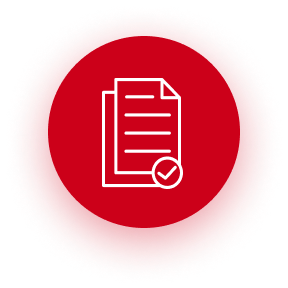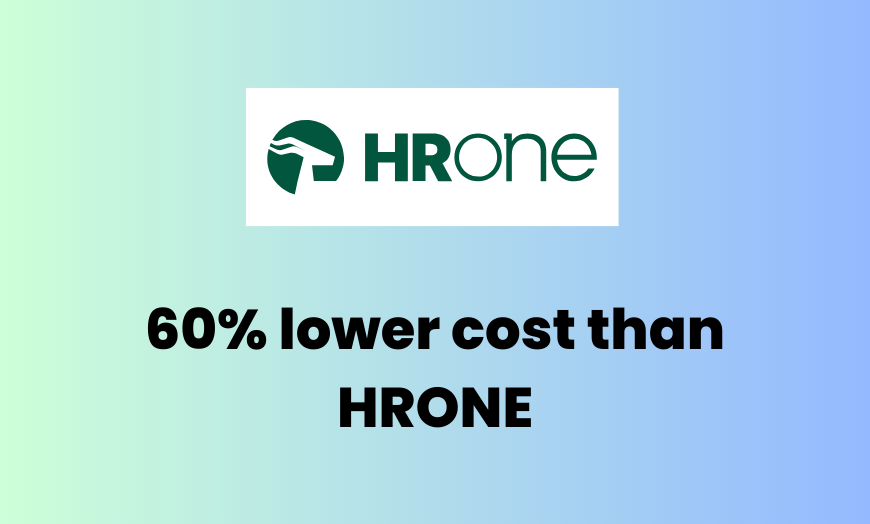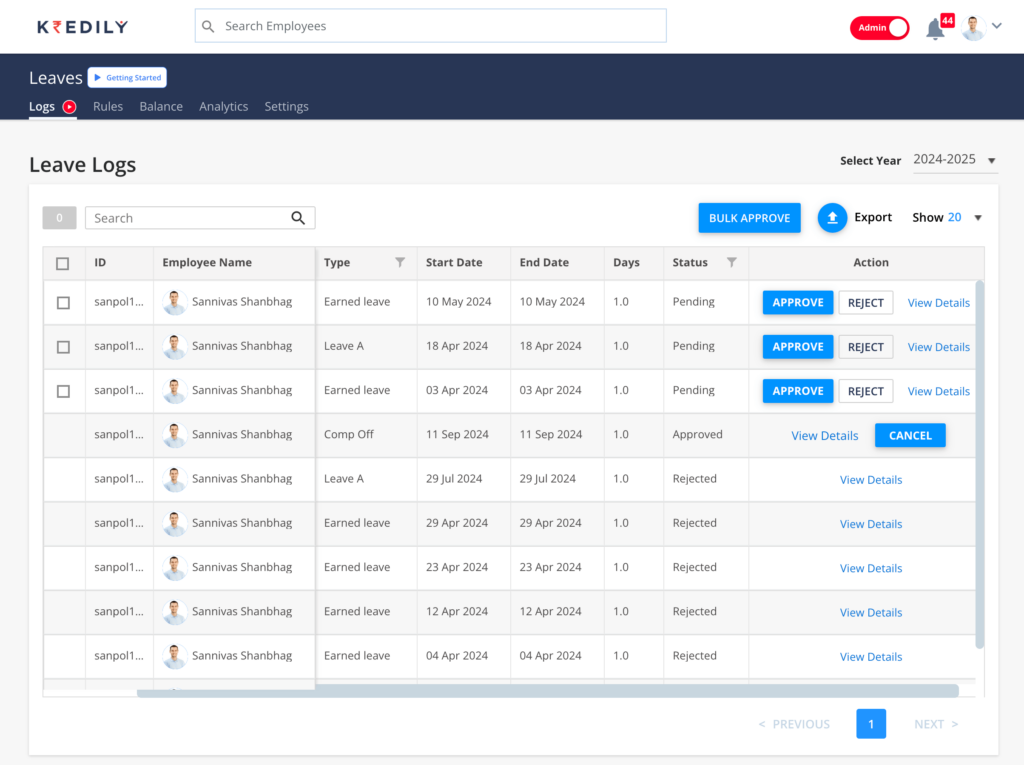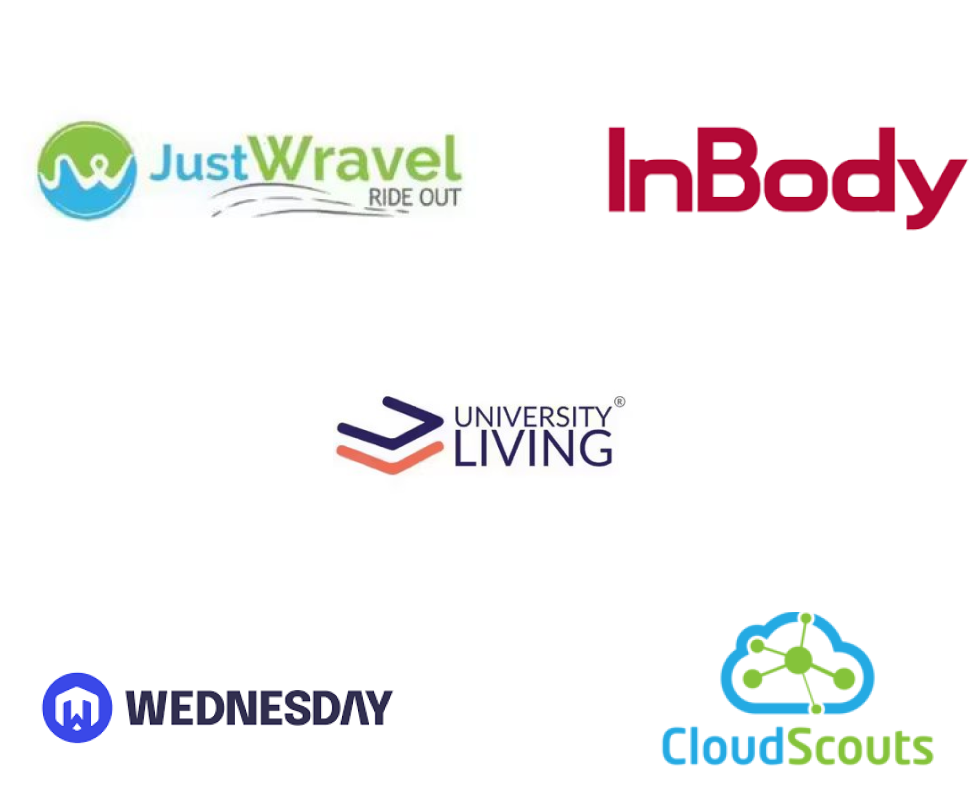Leave Management System That Empowers Your Workforce Effortlessly
Now manage all the leave requests quickly without wasting time on procedures.
Existing User? Sign In
Now manage all the leave requests quickly without wasting time on procedures.
Existing User? Sign In

Our leave administration system enables employees to request leave online, and managers can then approve or reject these requests based on their availability and other relevant factors.

Kredily's leave system accommodates a range of leave types, such as casual, vacation, sick, personal, and maternity/paternity, while also keeping track of leave balances for improved planning.

Companies are required to adhere to state and central leave calendars as well as legal regulations that mandate the provision of specific types of leave to employees.

Our attendance management system is capable of sending automated notifications to both employees and managers regarding the status of leave requests, including approvals, rejections, and updates.

Customize your leave policies to align with your organization's requirements using Kredily's Customizable Leave Rules feature. Create and enforce tailored leave policies, encompassing accrual rules, approval workflows, and more, to ensure a flexible and efficient leave system.

Our leave management system provides managers with a calendar view of employee leave requests, preventing scheduling conflicts. Managers can easily approve or deny requests based on factors like availability and workload.
Kredily HRMS provides unbeatable value with the lowest cost per user in the market.



With our leave management system, your company can keep precise and current records of employee leave history, providing valuable assistance in audits or potential legal disputes.
The Leave reports can produce detailed reports on leave usage, remaining balances, and historical trends, empowering managers to make data-driven decisions regarding staffing and resource allocation.
All leave details and the Attendance Management System seamlessly integrate with the payroll software, ensuring accurate compensation for employees.
A centralized database stores all employee leave information, simplifying the tracking and management of employee time off.
Implementing a leave system like Kredily serves three essential purposes for your company: enhancing efficiency, ensuring compliance with labor laws and internal policies, and boosting employee satisfaction. With Kredily, you can streamline the leave process, guarantee adherence to regulations, and provide employees with a user-friendly interface. Elevate your leave management, maintain compliance, and cultivate a more joyful work environment with Kredily’s leave system.











As a expanding non-profit organization, we were in search of an HR solution that could efficiently handle our fundamental HR operations without a significant financial burden. This is where Kredily came to our rescue! Kredily provided us with a Core HR suite completely free of charge. Its straightforward and user-friendly interface is remarkably intuitive and doesn't necessitate any training for implementation. It's quite noteworthy that in India, an HRIS company is offering such valuable services to clients without any cost.
We are highly content and delighted to have discovered Kredily as our HRMS partner. Throughout our collaboration, Kredily has cultivated a deep understanding of our unique vision and workflows, effectively aligning with our operations without causing any disruptions or complications on our end.
I discovered Kredily at precisely the moment when I began exploring HR tools and services for our operations. As a founder of a startup, I found myself dedicating a significant amount of time to manage attendance, leave, and payroll records. Kredily brought a higher level of transparency to our company's HR processes. The setup process was straightforward and well-guided. Personally, I appreciated the comprehensive information provided within the application about HR procedures.
We take immense satisfaction in our partnership with Kredily, which has proven immensely beneficial in streamlining our HRMS operations. For a small NGO such as ours, having access to a comprehensive solution on a single platform for managing employee records and authorization has been invaluable. This support has significantly contributed to our efforts in establishing our organization as an efficient institution.
Streamingo, a startup operating in the field of Artificial Intelligence, shares the common challenge with all bootstrapped startups in seeking a cost-effective HRMS solution. We were pleasantly amazed to discover that Kredily not only provides a user-friendly HRMS solution but also does so at zero cost. Kredily encompasses many of the features typically found in standard HRMS solutions and boasts remarkable simplicity and ease of use.
Managing employee leaves manually can be time-consuming, error-prone, and often leads to confusion between HR, managers, and employees. A Leave Management System (LMS) simplifies the entire process by automating leave requests, approvals, tracking, and payroll integration.
Accuracy in records – Prevents miscalculations of leave balances, encashments, or deductions.
Transparency – Employees and managers can clearly view leave entitlements and history, reducing disputes.
Compliance – Helps organizations adhere to statutory leave requirements under Indian labor laws.
Kredily’s LMS automates the leave lifecycle from request to approval. Employees can apply for leave through the portal or mobile app, managers receive instant notifications, and HR has a centralized dashboard to track everything.
Self-service for employees – Apply, cancel, or check leave balances without HR intervention.
Manager approvals – Managers can approve or reject requests instantly, even on mobile.
Real-time updates – Balances are updated automatically after each approved leave.
Payroll integration – Approved leaves (paid/unpaid) sync directly with payroll for accurate salary processing.
The system ensures smooth coordination between employees, managers, and HR with minimal manual effort.
Yes. Kredily’s LMS is highly flexible and allows organizations to configure policies according to their internal rules and industry norms.
Custom leave types – Sick leave, casual leave, earned leave, maternity leave, etc.
Accrual rules – Define monthly or yearly leave accruals.
Carry-forward and encashment – Decide whether unused leaves can be carried forward or encashed.
Probation rules – Restrict or adjust leave eligibility for employees under probation.
Holiday calendars – Add region-specific or company-specific holidays.
This flexibility ensures the system adapts to your policies rather than forcing you to change them.
Yes, and this is one of its biggest strengths. When leaves are approved or rejected, the information directly reflects in payroll, eliminating manual reconciliation.
Automatic salary deductions – For unpaid leaves.
Leave encashment – Seamlessly added to payroll when employees encash unused leave.
Compliance-ready – Statutory requirements like earned leave calculations are auto-managed.
Error-free payroll – HR avoids double work and mistakes while processing salaries.
This integration makes payroll faster, more accurate, and stress-free.
Yes. Employees and managers receive real-time notifications via email or mobile app.
Employees – Get instant updates when leave is approved, rejected, or modified.
Managers – Receive alerts when team members apply for leave.
HR/Admins – Can configure system-wide reminders and alerts.
This reduces communication delays and ensures everyone stays informed.
Kredily’s LMS is built keeping Indian labor laws in mind. It helps companies follow statutory requirements while still allowing customization.
Legal compliance – Adheres to laws on earned leave, maternity leave, and other mandatory entitlements.
Policy alignment – Ensures leaves are processed as per company’s internal HR policy.
Audit-friendly – Maintains detailed logs of leave transactions, useful during labor inspections.
Flexibility – Organizations can update policies in the system whenever laws or internal rules change.
This minimizes legal risks and ensures both company and employees are protected.
Yes, Kredily provides comprehensive reports for HR and management.
Leave balances – Track available leaves for each employee.
Usage trends – See which departments take the most leaves and when.
Patterns – Identify frequent absenteeism or misuse.
Export options – Reports can be downloaded in Excel/PDF for record-keeping.
These insights help in workforce planning and policy improvement.
Yes. All leave data is stored in a secure, centralized system accessible only to authorized personnel.
Single source of truth – No confusion between multiple spreadsheets or emails.
Data security – Information is encrypted and access-controlled.
Easy retrieval – Managers and HR can quickly pull up records when needed.
Transparency – Employees can also check their own leave history anytime.
This centralized setup saves time and avoids data silos.
Implementing Kredily’s LMS provides multiple business advantages:
Time savings – Automated approvals and payroll sync save HR hours every month.
Cost savings – Reduces errors that lead to overpayment or disputes.
Employee satisfaction – Transparent leave balances and fast approvals create trust.
Better planning – Managers can plan workloads based on real-time leave data.
Compliance assurance – Minimizes risk of penalties for labor law violations.
The overall result is an efficient, compliant, and employee-friendly workplace.
Getting started is quick and hassle-free:
Sign up on Kredily’s platform. https://kredily.com/
Configure policies – Add your organization’s leave types, rules, and holiday calendar.
Onboard employees – Upload employee details or integrate with your existing HRMS.
Train users – Simple orientation for employees and managers.
Go live – Start processing leave requests instantly.
Since it’s cloud-based, no heavy IT setup is needed.
Companies use it to:
Reduce errors in leave tracking
Save HR time by automating approvals and calculations
Give employees transparency into their leave balances
Ensure compliance with company policies and labor laws
Employees apply for leave online or via mobile. The software:
Checks policy rules automatically
Updates leave balances instantly
Notifies managers for approval
Integrates with payroll so approved leaves adjust salary if needed
Yes. Modern LMS platforms, including Kredily, handle all common and custom leave categories:
Sick leave
Casual leave
Earned leave
Maternity/paternity leave
Comp-off
Unpaid leave
Organizations can also create custom leave types as per policy.
Yes. Kredily’s LMS is mobile-friendly, allowing employees and managers to manage leaves anytime, anywhere.
Employees – Apply and track leave from their phones.
Managers – Approve or reject instantly, even while traveling.
HR/Admins – Monitor balances and reports from mobile dashboards.
This makes the system convenient for today’s hybrid and remote work culture.
AI brings intelligence to leave tracking by predicting trends and improving decision-making.
Predictive insights – AI can forecast peak leave seasons.
Pattern recognition – Detects frequent absenteeism or misuse.
Policy optimization – Suggests changes in leave rules based on usage trends.
Employee engagement – Helps HR understand workforce behavior better.
AI transforms LMS from a tracking tool into a workforce management solution.
When leave management is part of a full HRMS like Kredily, the benefits multiply:
Integration with payroll – Leaves directly affect salaries.
Centralized data – Attendance, leave, and payroll all in one place.
Scalability – Works for small businesses and enterprises alike.
Automation – Reduces manual intervention across HR processes.
This holistic approach ensures HR runs smoothly end-to-end.
Yes, data security is a top priority. Kredily ensures:
Data encryption – Protects sensitive employee data.
Access control – Only authorized personnel can view records.
Regular backups – Ensures no data loss.
Compliance – Adheres to data protection laws and best practices.
This guarantees confidentiality and reliability of employee information.
.
Choosing the right LMS depends on your company’s size, policies, and budget. Key factors include:
Ease of use – Simple interface for employees and managers.
Customization – Ability to define your own policies.
Integration – Works seamlessly with payroll and attendance.
Scalability – Grows with your organization.
Support – Availability of training and customer service.
Evaluating these ensures you select software that truly fits your needs.
Setup time is minimal with cloud-based solutions like Kredily.
Basic setup – A few hours to configure leave policies and onboard employees.
Advanced setup – 1–2 days if complex rules or integrations are needed.
Training – Quick and simple, since the system is user-friendly.
Most organizations can go live within 1–3 days and start enjoying the benefits almost immediately.